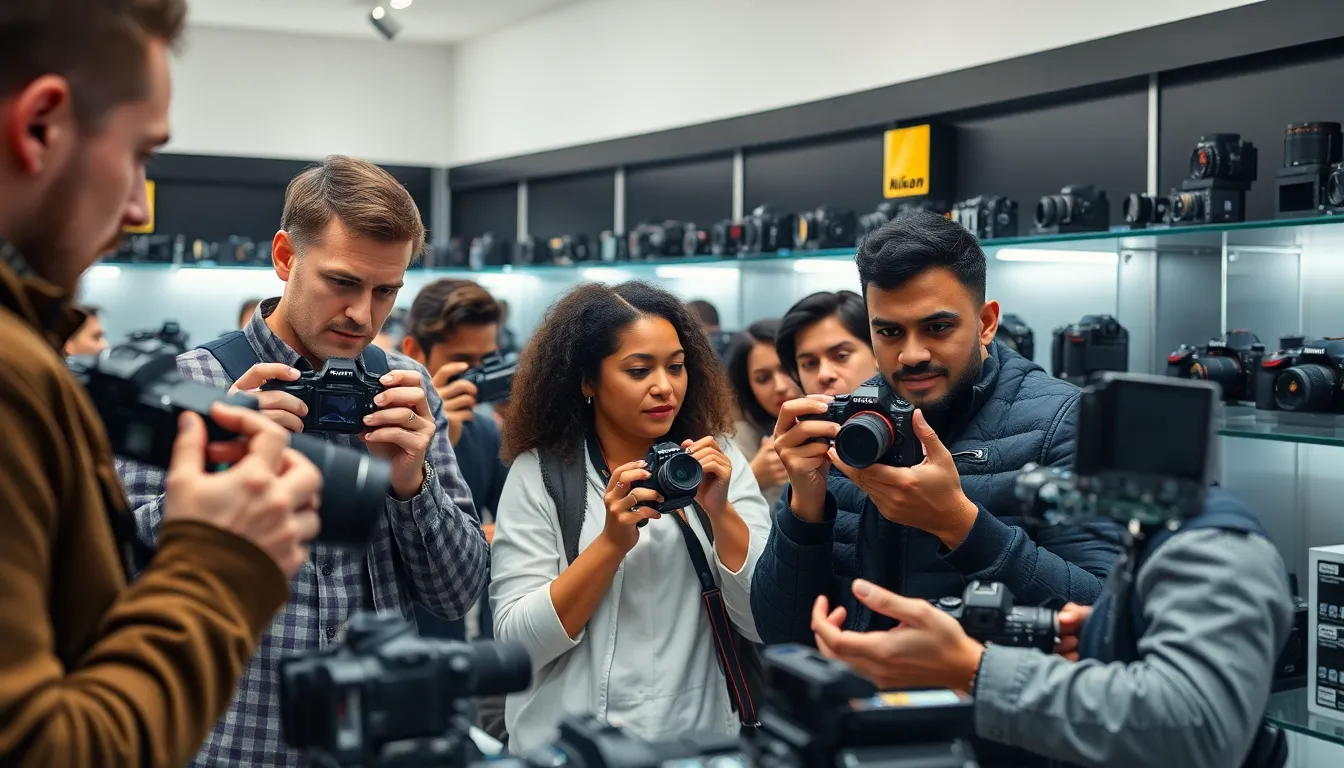In a world where visual storytelling reigns supreme, choosing the right camera can make all the difference. Whether capturing breathtaking landscapes, candid moments, or stunning portraits, the right equipment empowers creators to express their vision. With technology evolving rapidly, navigating the myriad of options can feel overwhelming.
Camera reviews serve as essential guides, helping enthusiasts and professionals alike sift through the noise. They provide insights into performance, features, and usability, ensuring that every photographer finds the perfect match for their needs. From budget-friendly models to high-end gear, understanding the strengths and weaknesses of each camera can elevate one’s photography game to new heights.
Table of Contents
ToggleOverview of Camera Reviews
Camera reviews provide essential insights into various models, supporting users in making informed purchasing decisions. Reviews assess key factors such as image quality, autofocus performance, battery life, and build design. They highlight unique features and usability, allowing photographers to understand how different cameras perform under various conditions.
Professional reviewers often conduct side-by-side comparisons, offering direct assessments of similar models. These comparisons showcase differences in specifications, pricing, and user experience, aiding users in weighing their options effectively.
User-generated reviews also play a vital role, reflecting real-world experiences. Feedback from actual users reveals advantages and drawbacks, helping potential buyers gauge the reliability and performance over time. Reviews that include sample images further enhance understanding, illustrating how each camera handles diverse subjects.
In addition to providing information, camera reviews often include ratings or scores, offering a quick reference to overall performance. This structured evaluation aids in narrowing down choices, as buyers can easily compare options based on specific needs whether they’re beginners or professionals seeking advanced capabilities.
Popular Camera Brands

Numerous camera brands dominate the market, each providing unique features and capabilities. Understanding these brands helps users make informed decisions.
Canon
Canon excels in producing versatile cameras suitable for all skill levels. It offers a broad range of DSLRs and mirrorless options, renowned for their exceptional image quality and robust autofocus systems. Canon’s EOS series is particularly popular, featuring models like the EOS R5, which supports high-resolution photography and 8K video recording. Additionally, Canon’s user-friendly interfaces enhance usability, making it a favorite among both professionals and hobbyists.
Nikon
Nikon is known for its emphasis on optical performance and durable build quality. With a solid lineup of DSLRs and mirrorless cameras, Nikon caters to various photographers. The Nikon Z series has gained praise for its innovative technology, including fast hybrid autofocus and excellent low-light performance in models like the Z6 II. Nikon’s long history in camera manufacturing contributes to a deep understanding of photographers’ needs, offering features that support creative endeavors.
Sony
Sony leads the market in mirrorless camera technology, pushing boundaries with advanced features. Its Alpha series cameras, such as the A7 III, showcase impressive image quality, fast autofocus, and excellent video capabilities, making them ideal for both photographers and videographers. Sony’s sensor technology often outpaces competitors, providing outstanding dynamic range and low-light performance. The brand’s commitment to innovation ensures photographers have access to the latest advancements in camera technology.
Types of Cameras
Different types of cameras cater to various photography styles and preferences. Understanding these categories helps users select the best option based on their specific needs.
DSLR Cameras
DSLR (Digital Single-Lens Reflex) cameras feature a mirror mechanism that allows users to view exactly what the lens sees. They offer advantages such as:
- Image Quality: High-resolution sensors deliver sharp and vibrant images.
- Interchangeable Lenses: Compatibility with a wide range of lenses, including wide-angle and telephoto options.
- Optical Viewfinder: Provides a real-time view of the scene with minimal lag.
- Manual Controls: Extensive control over settings like shutter speed, aperture, and ISO for creative flexibility.
Popular models include Canon EOS 90D and Nikon D7500, which offer advanced features while catering to various skill levels.
Mirrorless Cameras
Mirrorless cameras lack the mirror mechanism found in DSLRs, leading to a more compact design. Key characteristics include:
- Lightweight Design: Easier to carry, making them ideal for travel and street photography.
- Electronic Viewfinder: Displays real-time exposure information and focus assist tools.
- Fast Autofocus: More efficient focusing capabilities, particularly in dynamic situations.
- Interchangeable Lenses: Similar lens versatility as DSLRs, with options for high-quality glass.
Notable models include Sony Alpha 7 III and Fujifilm X-T4, both praised for their image quality and operational speed.
Compact Cameras
Compact cameras, also known as point-and-shoot cameras, emphasize portability and user-friendliness. They offer several advantages:
- Ease of Use: Simple controls and automatic settings make photography accessible for beginners.
- Built-In Lens: Fixed lenses eliminate the hassle of carrying multiple lenses.
- Pocket-Sized Portability: Convenient design allows for easy transport on trips or outings.
- Affordable Pricing: Generally lower price points compared to advanced models.
Popular choices include Canon PowerShot G7 X Mark III and Sony RX100 VII, both offering impressive performance in a sleek package.
Key Factors to Consider in Camera Reviews
When assessing camera reviews, focus on specific elements that determine the overall quality and usability of a camera. Key factors include image quality, performance, and features with accessories that enhance the photographic experience.
Image Quality
Image quality significantly impacts how photographs capture and represent scenes. Evaluations consider metrics such as resolution, dynamic range, and color accuracy. Resolutions typically range from 12 to 50 megapixels, affecting detail and cropping flexibility. Dynamic range, measured in exposure stops, indicates a camera’s ability to capture details in highlights and shadows. Color accuracy is often assessed using standardized tests, such as color checker charts, showcasing how true-to-life images appear. Sample images included in reviews often illustrate these characteristics, providing visual examples that resonate with potential buyers.
Performance
Performance includes various aspects affecting usability and functionality. Speed measures responsiveness in terms of autofocus acquisition and burst rates, commonly specified in frames per second (fps). For example, high-end models may achieve 12 fps or more, suitable for sports or wildlife photography. Battery life reflects how long a camera operates under continuous use, expressed in the number of shots achievable per charge. Reviewers also examine low-light performance, indicating how well a camera functions in darker environments, often referencing ISO range and noise levels found in images. Test results offer insights into these performance variables, guiding photographers toward models that align with their shooting needs.
Features and Accessories
Features and accessories play a crucial role in expanding camera capabilities and user experience. Reviewers focus on unique features, such as touchscreen interfaces, customizable settings, and in-camera stabilization, which enhance usability and flexibility. The availability of accessories, including lenses, external flashes, and grips, enhances a camera’s versatility. Some reviews cite compatibility with various lens systems, making it easier for users to adapt their equipment to different shooting styles. Information on software support and firmware updates contributes to long-term performance and user satisfaction. Comprehensive details about these features in reviews help photographers identify cameras that meet their creative requirements.
Choosing the right camera is crucial for anyone looking to elevate their visual storytelling. With the rapid advancements in technology and the vast array of options available, informed decisions become essential. Camera reviews serve as a valuable resource for photographers at every skill level, offering insights into performance and usability.
Whether someone is seeking a budget-friendly option or a high-end model, reviews provide essential information that helps narrow down choices. By understanding the strengths and weaknesses of different cameras, users can select gear that aligns with their specific needs and creative aspirations. Ultimately, informed choices lead to enhanced photography experiences and better storytelling through imagery.









